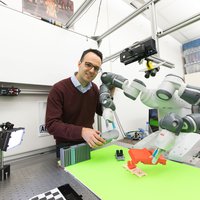Artificial intelligence & robotics
Jinxing Li
His tiny robots can be programmed to treat infection

Global
Liang Xu
Using AI to make cities more responsive to their residents

Europe
Juan Aparicio Ojea
He is accelerating the adoption of collaborative robots by using a system that helps them grab and manipulate objects they have never seen before

Latin America
Carlos Andrés Obando
His app uses AI to help people with visual impairments to recognize objects and colors without internet

Europe
Conor McGinn
His humanoid robot, Stevie, could improve the quality of life of older people through care and entertainment
